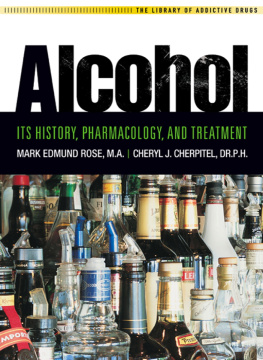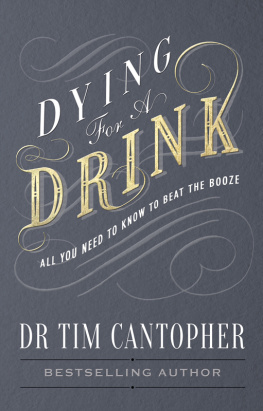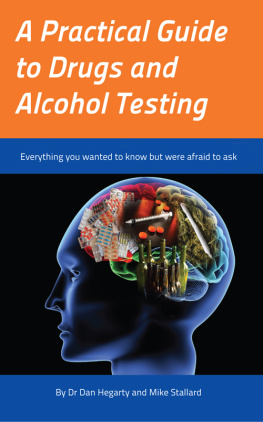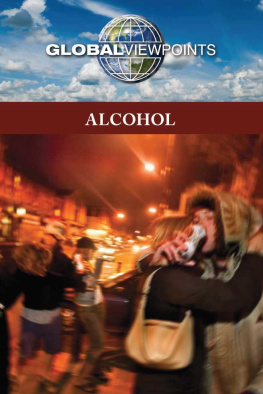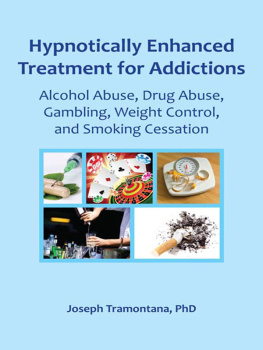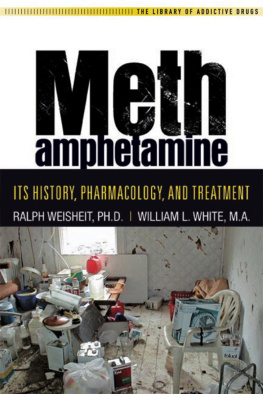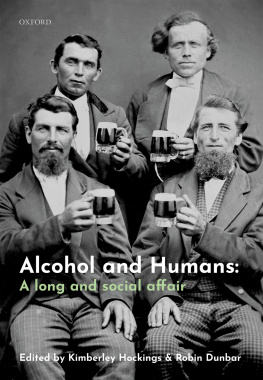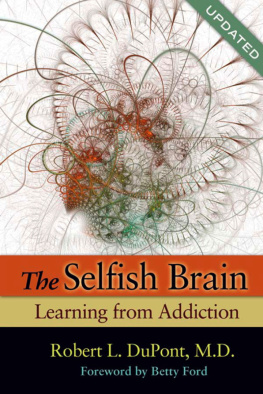THE LIBRARY OF ADDICTIVE DRUGS
Alcohol
ITS HISTORY, PHARMACOLOGY, AND TREATMENT
MARK EDMUND ROSE, M.A.,
and
CHERYL J. CHERPITEL, DR.P.H.

Hazelden Publishing
Center City, Minnesota 55012
800-328-9000
hazelden.org/bookstore
2011 by Hazelden Foundation
All rights reserved. Published 2011.
Printed in the United States of America
No part of this publication may be reproduced, stored in a retrieval system, or transmitted in any form or by any meanselectronic, mechanical, photocopying, recording, scanning, or otherwisewithout the express written permission of the publisher. Failure to comply with these terms may expose you to legal action and damages for copyright infringement.
Library of Congress Cataloging-in-Publication Data
Rose, Mark Edmund.
Alcohol: its history, pharmacology, and treatment / Mark Edmund Rose and Cheryl J. Cherpitel.
p. cm.
Includes bibliographical references and index.
ISBN 978-1-61649-147-5 (softcover) ISBN 978-1-61649-403-2 (e-book)
1. Drinking of alcoholic beveragesUnited StatesHistory. 2. AlcoholismSocial aspectsUnited States. 3. AlcoholismPsychological aspectsUnited States. 4. AlcoholismTreatmentUnited StatesHistory. I. Cherpitel, Cheryl J. II. Title.
HV5015.R67 2011
616.861dc23
2011037772
Editors note
This publication is not intended as a substitute for the advice of health care professionals.
Alcoholics Anonymous, AA, the Big Book, the Grapevine, AA Grapevine, and GV are registered trademarks of Alcoholics Anonymous World Services, Inc.
Hazelden offers a variety of information on chemical dependency and related areas. The views and interpretations expressed herein are those of the authors and are neither endorsed nor approved by AA or any Twelve Step organization.
14 13 12 11 1 2 3 4 5 6
Cover design by Theresa Jaeger Gedig
Interior design by Madeline Berglund
Typesetting by BookMobile Design and Publishing Services
ACKNOWLEDGMENTS
A funny thing happened along the way as I [Mark Rose] was preparing to enter treatment for drug and alcohol dependence. It was June 1983, and my grade point average at UC Santa Barbara had just slid below 2.0. I returned home for the summer and had several meetings with concerned professionals, which had been arranged by my parents. I agreed to go into treatment after finishing a summer class at UC San Diego, where an A would get me out of academic probation. Concluding that psychopharmacology was my best shot, I enrolled in a course taught by an unknown, entry-level instructor named George Koob, Ph.D. (now one of the top addiction scientists in the world). I became fascinated with learning about how therapeutic and recreational drugs acted on the brain to produce their effects, and I frequently visited with Dr. Koob. I took the final exam, entered treatment the next day, and got my A.
I would sincerely like to thank Dr. Koob for igniting a passion; my former boss Mark Willenbring, M.D.; undergraduate mentor Harry Hoberman, Ph.D.; supervisor Warren Maas, L.P., J.D.; and friend Aviel Goodman, M.D., for their hugely influential role in helping me define and shape my professional interests and direction.
I would also like to express my gratitude to my parents for their unwavering love and support, my uncle Walt and grandmother Lilli (we called her Nana) for their incredible caring and emotional generosity while they were around, all my close friends along the way, and my sister Karen Rose Werner and friends Jonathan Rice, Seamus Mahoney, and Mark Mahowald, M.D., for their input while this book was being written. And finally, I would like to thank Aviel Goodman, M.D., for his time and invaluable peer review and critique of the chapter on the science of alcohol and alcoholisms.
The following authors and/or publishers have graciously granted permission to use material from their work:
Coyhis, D. L., and W. L. White. 2006. Alcohol Problems in Native America: The Untold Story of Resistance and Recovery. Colorado Springs: White Bison, Inc.
DDA (Dual Diagnosis Anonymous). 1996. 12 Steps + 5: Original Concept Paper. Dual Diagnosis Anonymous of Oregon Inc. website. Accessed Apr. 8, 2011. www.ddaoregon.com/about.htm.
Dole, Vincent P. 1991. Addiction as a Public Health Problem, Alcoholism: Clinical and Experimental Research 15, no. 5. (October 1991): 749752. Published by John Wiley and Sons. 1991, John Wiley and Sons.
Garland, E. L., S. A. Gaylord, C. A. Boettiger, and M. O. Howard. 2010. Mindfulness Training Modifies Cognitive, Affective, and Physiological Mechanisms Implicated in Alcohol Dependence: Results of a Randomized Controlled Pilot Trial. Journal of Psychoactive Drugs 42:177192.
Gorski, T. T., and M. Miller. 1982. Counseling for Relapse Prevention . Independence, MO: Independence Press. This material is copyrighted and proprietary information of Terence T. Gorski.
Harwood, H. 2000. Updating Estimates of the Economic Costs of Alcohol Abuse in the United States: Estimates, Update Methods, and Data. Report prepared by The Lewin Group for the National Institute on Alcohol Abuse and Alcoholism. Based on estimates, analyses, and data reported in Harwood, H., D. Fountain, and G. Livermore. 1998. The Economic Costs of Alcohol and Drug Abuse in the United States 1992. Report prepared for the National Institute on Drug Abuse and the National Institute on Alcohol Abuse and Alcoholism, National Institutes of Health, Department of Health and Human Services. NIH Publication No. 98-4327. Rockville, MD: National Institutes of Health.
Henderson, Elizabeth Connell. 2000. Understanding Addiction. Copyright 2000 by University Press of Mississippi.
Miller, W. R., and R. J. Harris. 2000. Simple Scale of Gorskis Warning Signs for Relapse. Journal of Studies on Alcohol 61:759765. Items reproduced with permission from Alcohol Research Documentation, Inc., publisher of the Journal of Studies on Alcohol, now the Journal of Studies on Alcohol and Drugs (www.jsad.com). This material is copyrighted and proprietary information of Terence T. Gorski.
White, William L. 2007. In Search of the Neurobiology of Addiction Recovery: A Brief Commentary on Science and Stigma. www.facesandvoicesofrecovery.org/pdf/White/White_neurobiology _2007.pdf. (Also available at www.williamwhitepapers.com.)
WHO (World Health Organization). 2008. Core Health Indicators: Per Capita Recorded Alcohol Consumption (Litres of Pure Alcohol) among Adults (>=15 Years). Accessed Sept. 15, 2011. http://apps.who.int/whosis/database/core/core_select_process.cfm?strISO3 _select=ALL&strIndicator_select=AlcoholConsumption&intYear _select=latest&language=english.
The excerpts from the pamphlet Three Talks to Medical Societies are reprinted with permission of Alcoholics Anonymous World Services, Inc. (AAWS). Permission to reprint these excerpts does not mean that AAWS necessarily agrees with the views expressed herein. A.A. is a program of recovery from alcoholism only use of these excerpts in connection with programs and activities which are patterned after A.A., but which address other problems, or in any other non A.A. context, does not imply otherwise.
INTRODUCTION
Alcohol is unique among recreational drugs. On one hand, many people enjoy drinking alcohol and are able to do so without harming themselves or others. On the other hand, 15% of all persons who drink alcohol will develop an addiction to alcohol (also called alcoholism or alcohol dependence) (Anthony et al. 1994; Chen and Anthony 2004; Hughes et al. 2006).

